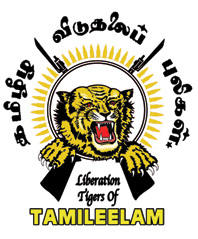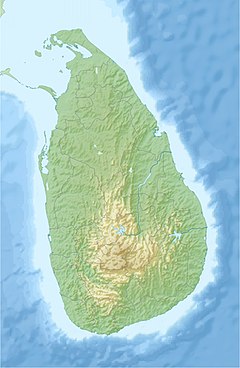
The Liberation Tigers of Tamil Eelam was a Tamil militant organization that was based in northeastern Sri Lanka. The LTTE fought to create an independent Tamil state called Tamil Eelam in the north-east of the island, due to the continuous discrimination and violent persecution against Sri Lankan Tamils by the Sinhalese dominated Sri Lankan Government.

The Sri Lankan Civil War was a civil war fought in Sri Lanka from 1983 to 2009. Beginning on 23 July 1983, there was an intermittent insurgency against the government by the Velupillai Prabhakaran-led Liberation Tigers of Tamil Eelam. The LTTE fought to create an independent Tamil state called Tamil Eelam in the north-east of the island, due to the continuous discrimination and violent persecution against Sri Lankan Tamils by the Sinhalese dominated Sri Lankan Government.

Indian Peace Keeping Force (IPKF) was the Indian military contingent performing a peacekeeping operation in Sri Lanka between 1987 and 1990. It was formed under the mandate of the 1987 Indo-Sri Lankan Accord that aimed to end the Sri Lankan Civil War between Sri Lankan Tamil militant groups such as the Liberation Tigers of Tamil Eelam (LTTE) and the Sri Lankan military.
Vinayagamoorthy Muralitharan is a Sri Lankan politician and former militant. After fighting for the Liberation Tigers of Tamil Eelam for over 20 years, he rose to prominence as the leader of the Tamil Makkal Viduthalai Pulikal (TMVP), a breakaway faction of the LTTE.
The Nager Kovil school bombing refers to an airstrike that took place on September 22, 1995, when the Sri Lankan Air Force bombed the Nagar Kovil Maha Vidyalayam school in Jaffna, resulting in the death of, by varying accounts, 34-71 Sri Lankan Tamil civilians, primarily schoolchildren and the injury of many more. Sri Lankan Defense Spokesman admitted the incident but claimed that it was a LTTE facility and most of the dead were LTTE cadres. Journalists and human rights organizations reported the imposition of censorship and the airstrike took place about 12 hours after the Government imposed press censorship on reporting military events.
The expulsion of the Muslims from the Northern province was an act of ethnic cleansing carried out by the Tamil militant Liberation Tigers of Tamil Eelam (LTTE) organization in October 1990. Yogi, the LTTE's political spokesman claimed that this expulsion was carried out in retaliation for atrocities committed against Tamils in the Eastern Province by Muslims, who were seen by the LTTE as collaborators with the Sri Lankan Army. As a consequence, in October 1990, the LTTE forcibly expelled 72,000 strong Muslim population from the Northern Province.

Operation Poomalai, also known as Eagle Mission 4, was the codename assigned to a mission undertaken by the Indian Air Force for airdropping supplies over the besieged town of Jaffna in Sri Lanka on 4 June 1987 to support the Tamil Tigers during the Sri Lankan Civil War.

The Chencholai bombing took place on August 14, 2006 when the Sri Lankan Air Force bombed what it said was a rebel Liberation Tigers of Tamil Eelam (LTTE) training camp, killing 61 girls aged 16 to 18. The LTTE, UNICEF, SLMM and UTHR all said those in the compound were not LTTE cadres.
The Kent and Dollar Farm massacres were one of the earliest massacres carried out by the LTTE during the Sri Lankan Civil War. The massacres took place on 30 November 1984, in two tiny farming villages in the district of Mullaitivu in north-eastern Sri Lanka. The Sri Lankan government labeled this as an attack on civilians by the LTTE.
The Anuradhapura massacre occurred in Sri Lanka in 1985 and was carried out by the Liberation Tigers of Tamil Eelam. This was the largest massacre of Sinhalese civilians by the LTTE to date; it was also the first major operation carried out by the LTTE outside a Tamil majority area. Initially, EROS claimed responsibility for the massacre, but it later retracted the statement, and joined the PLOTE in denouncing the incident. The groups later accused the LTTE for the attack. Since then, no Tamil militant group has admitted to committing the massacre. However, state intelligence discovered that the operation was ordered by the LTTE's leader Velupillai Prabhakaran. He assigned the massacre to the LTTE Mannar commander Victor and it was executed by Victor's subordinate Anthony Kaththiar. The attack was allegedly sparked by the 1985 Valvettiturai massacre, where the Sri Lanka Army massacred 70 Tamil civilians in Prabhakaran's hometown.
The Kalmunai massacre refers to a series of mass killings that occurred in June 1990 in Kalmunai, a municipality within the Ampara District of Sri Lanka's Eastern Province. The massacre of civilians was allegedly carried out by the Sri Lankan Army in retaliation for an earlier massacre of Sri Lankan police officers. The University Teachers for Human Rights, a human rights organization, put the number of dead in the second massacre at 250, while a local Member of Parliament claimed that at least 160 people were killed.
Eelam War I is the name given to the initial phase of the armed conflict between the government of Sri Lanka and the LTTE.
A mass murder of Sri Lankan Police officers took place on 11 June 1990. Members of the Liberation Tigers of Tamil Eelam (LTTE), a militant organization, are alleged to have killed over 600 unarmed Sri Lanka Police officers in Eastern Province, Sri Lanka. Some accounts have estimated the number killed as high as 774.

The 1985 Trincomalee massacres refers to a series of mass murder of Tamil civilians by the Sri Lankan military and Sinhalese home guards in Trincomalee District, Sri Lanka. In a succession of events that spanned over two months, hundreds of Tamil civilians were massacred and thousands were driven out by the Sri Lankan military and Sinhalese mobs in order to colonize the area. Almost every Tamil settlement in the district was destroyed during this well-orchestrated campaign to drive out the local Tamil population. Several Tamil women were also raped. In September 1985, the entire Tamil population of Trincomalee town was displaced to forests and refugee camps in an attack that wiped out the town, including the destruction of 12 temples and a mosque.
The following lists events that happened during 1990 in Sri Lanka.

The 1987 Eastern Province massacres were a series of massacres of the Sinhalese population in the Eastern Province of Sri Lanka by Tamil mobs and Liberation Tigers of Tamil Eelam during the Sri Lankan Civil War. Though they began spontaneously, they became more organized, with the LTTE leading the violence. Over 200 Sinhalese were killed by mob and militant violence, and over 20,000 fled the Eastern Province. The violence has been described as having had the appearance of a pogrom.
The Murunkan massacre of Inspector Bastianpillai and his team of police officers was the mass murder of a team of CID officers of the Sri Lanka Police on 7 April 1978 in the jungles of Murunkan in the Vavuniya District. Four police officers including Inspector Bastianpillai were killed by LTTE members led by Uma Maheswaran.
Sexual violence against Tamils in Sri Lanka has occurred repeatedly during the island's long ethnic conflict. The first instances of rape of Tamil women by Sinhalese mobs were documented during the 1958 anti-Tamil pogrom. This continued in the 1960s with the deployment of the Sri Lankan Army in Jaffna, who were reported to have molested and occasionally raped Tamil women.








